Introduction
The Pattern divides into distinct groups, with Mills Equipment Company and M. Wright & Sons producing the definitive forms, because only they were capable of integral- and reduction-weaving. Other U.K. companies had to produce the same items in a more expedient way and the Empire had to resort to even more variations. Of the latter, the ultimate form were the later forms of Canadian manufacture. Although a view might be held that this second group are “ersatz”, the products are in webbing and not a substitute. This includes South Africa’s use of laminated materials, because it was still “webbing”, even if only akin to that used in upholstery.
However, there was a third group of Patt. ’37 W.E. items, which did not use webbing. Use was confined to strapping, of both 1 and 2-inch widths and no larger expanses of this material are known, making up complete envelopes.
The material is an “ersatz” measure, since it is loosely “canvas” and, by its close weave, more accurately cotton duck. Canvas is a “plain weave”, but duck is often twilled, i.e. with a diagonal ribbed effect. Two forms have been noted, one plain weave, the other the form of duck, which has two yarns together in the warp (the lengthwise threads) and a single yarn in the weft (sideways threads). In the latter case, the material appears to have been cut across the direction of weaving, so warp & weft have switched places.
Two pieces of material, with a central rubber layer, are stitched together to make a laminated composite. This was flexible when new, but today’s collector is faced with these having become brittle and inflexible with age, despite looking very “new”. Another form comprise the material folded parallel to and towards the centre-line of the strap, where it stitched into place.
No specific nomenclature appears to have been given to these variants, so “ersatz” is as good as any, until such time as something more specific surfaces.
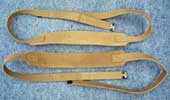
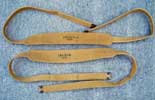
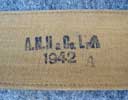
 These are of twilled weave, in its simplest form, so the diagonal pattern is visible, but not marked, as in twilled clothing. They are of three-piece construction, of “sewn-to” form, the junction being on the outside of the flared section. The underside is marked A.N.H. & Co. Ltd. (A. N. Holden & Co. Ltd.) 1942. In the group of Braces at right, A.C. is Associated Cutters (1938) Ltd.; H.H.C. & Co. Ltd is H.H. Carroll & Co. ; S.N. LTD shows the complete form absent on the Haversack strap below and is S. Noton Ltd. All examples from the Collection of Nick Wall, photos © Nick Wall 2009.
These are of twilled weave, in its simplest form, so the diagonal pattern is visible, but not marked, as in twilled clothing. They are of three-piece construction, of “sewn-to” form, the junction being on the outside of the flared section. The underside is marked A.N.H. & Co. Ltd. (A. N. Holden & Co. Ltd.) 1942. In the group of Braces at right, A.C. is Associated Cutters (1938) Ltd.; H.H.C. & Co. Ltd is H.H. Carroll & Co. ; S.N. LTD shows the complete form absent on the Haversack strap below and is S. Noton Ltd. All examples from the Collection of Nick Wall, photos © Nick Wall 2009.
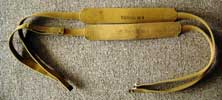 Another pair of ersatz Braces. The left Brace has a crossover loop which, interestingly, is made of web. Maker marked "D&M LTD" (Durie & Miller Ltd.) and dated 1942. From the Barry O'Sullivan Collection. Photo © Barry O'Sullivan 2012.
Another pair of ersatz Braces. The left Brace has a crossover loop which, interestingly, is made of web. Maker marked "D&M LTD" (Durie & Miller Ltd.) and dated 1942. From the Barry O'Sullivan Collection. Photo © Barry O'Sullivan 2012.

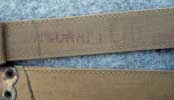 These are of plain weave, with the duck being folded around the 1-inch buckle, then folded under to protect the cut end. The opposite end appears to have been folded, before the Tip, brass, 1-inch was riveted on, leaving the cut end exposed. The markings have not been deciphered. The second example is constructed by folding in once, to form a hem and then folding in again to the centreline. One Strap is maker marked "Bagcraft Ltd." and dated 1941. Both examples from the Collection of Nick Wall, photo © Nick Wall 2009.
These are of plain weave, with the duck being folded around the 1-inch buckle, then folded under to protect the cut end. The opposite end appears to have been folded, before the Tip, brass, 1-inch was riveted on, leaving the cut end exposed. The markings have not been deciphered. The second example is constructed by folding in once, to form a hem and then folding in again to the centreline. One Strap is maker marked "Bagcraft Ltd." and dated 1941. Both examples from the Collection of Nick Wall, photo © Nick Wall 2009.
 Another pair of Pack supporting straps. These were made with a different technique, with the outer duck cover is wrapped around the core lengthwise and then sewn, leaving two longitudinal seams. Maker marked "A&A" and dated 1946. From the Nick Wall Collection , photo © Nick Wall 2009.
Another pair of Pack supporting straps. These were made with a different technique, with the outer duck cover is wrapped around the core lengthwise and then sewn, leaving two longitudinal seams. Maker marked "A&A" and dated 1946. From the Nick Wall Collection , photo © Nick Wall 2009.

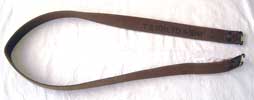 Two more Straps, supporting. The Strap far left is maker marked "D&M LTD" (Durie & Miller Ltd.) and dated 1941. The example near left is marked "T.S. (O) LTD." and dated 1941. Both from the Barry O'Sullivan Collection. Photos © Barry O'Sullivan 2012.
Two more Straps, supporting. The Strap far left is maker marked "D&M LTD" (Durie & Miller Ltd.) and dated 1941. The example near left is marked "T.S. (O) LTD." and dated 1941. Both from the Barry O'Sullivan Collection. Photos © Barry O'Sullivan 2012.
Straps, haversack, left and right
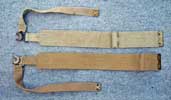

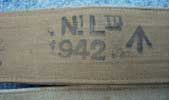 The under-arm 1-inch straps are standard cotton webbing and the section carrying the hook has been sewn to the underside of the flare, which is not normal. More probably the hooks have been orientated incorrectly. The marking of S.N. LTD is incomplete, but was S. Noton Ltd (Oldham). The exclamation mark between N and Ltd is the result of an over inked stamp, the side of the stamp having left a mark. From the Collection of Nick Wall, photos © Nick Wall 2009.
The under-arm 1-inch straps are standard cotton webbing and the section carrying the hook has been sewn to the underside of the flare, which is not normal. More probably the hooks have been orientated incorrectly. The marking of S.N. LTD is incomplete, but was S. Noton Ltd (Oldham). The exclamation mark between N and Ltd is the result of an over inked stamp, the side of the stamp having left a mark. From the Collection of Nick Wall, photos © Nick Wall 2009.
Other applications
No “envelope” has been noted, thus Pack and Haversack bodies, all Cases, Pockets and Pouches would seem to be ruled-out.
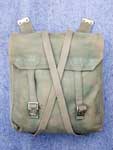
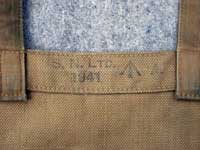 The flap straps and buckle chapes on some examples use the laminated material, the envelopes themselves being normal webbing. This Pack by S. Noton Ltd., 1941, is standard webbing, but the flap straps and flap buckle chapes are in ersatz material. Ersatz Supporting straps are fitted, but the 2-inch tabs here are normal webbing. Note the differing T.P.I.s (Threads Per Inch) on the stitching. From the Collection of Nick Wall. Photos © Nick Wall 2009.
The flap straps and buckle chapes on some examples use the laminated material, the envelopes themselves being normal webbing. This Pack by S. Noton Ltd., 1941, is standard webbing, but the flap straps and flap buckle chapes are in ersatz material. Ersatz Supporting straps are fitted, but the 2-inch tabs here are normal webbing. Note the differing T.P.I.s (Threads Per Inch) on the stitching. From the Collection of Nick Wall. Photos © Nick Wall 2009.
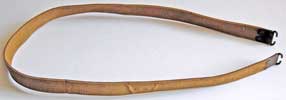
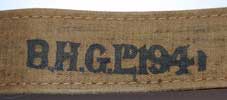 Although not a Patt. ’37 item, this is included here for completeness. The material in this example has a more distinctive twilled weave, but in all other respects it is fitted out as a Sling, rifle, web. The markings of B.H.G. Ld. 1941 are those of Barrow, Hepburn and Gale. Prior to the Second World War, they had operated primarily as leather manufacturers. At the time of the Great War, they were Hepburn, Gale and Ross (H.G.R.). From the Collection of Rog Dennis, photos © Rog Dennis 2009.
Although not a Patt. ’37 item, this is included here for completeness. The material in this example has a more distinctive twilled weave, but in all other respects it is fitted out as a Sling, rifle, web. The markings of B.H.G. Ld. 1941 are those of Barrow, Hepburn and Gale. Prior to the Second World War, they had operated primarily as leather manufacturers. At the time of the Great War, they were Hepburn, Gale and Ross (H.G.R.). From the Collection of Rog Dennis, photos © Rog Dennis 2009.